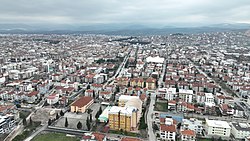You can help expand this article with text translated from the corresponding article in Italian. (May 2024)Click [show] for important translation instructions.
|
Marigliano | |
|---|---|
 Santuario della Madonna della Speranza | |
| Coordinates: 40°56′N14°27′E / 40.933°N 14.450°E | |
| Country | Italy |
| Region | Campania |
| Metropolitan city | Naples (NA) |
| Frazioni | Lausdomini, Casaferro, Miuli, Faibano, Pontecitra, San Nicola |
| Government | |
| • Mayor | Vincenzo Galdi |
| Area | |
• Total | 22.58 km2 (8.72 sq mi) |
| Elevation | 30 m (100 ft) |
| Population (30 September 2017) [2] | |
• Total | 29,915 |
| • Density | 1,300/km2 (3,400/sq mi) |
| Demonym | Mariglianesi |
| Time zone | UTC+1 (CET) |
| • Summer (DST) | UTC+2 (CEST) |
| Postal code | 80034 |
| Dialing code | 081 |
| Patron saint | Saint Sebastian |
| Saint day | 20 January |
| Website | Official website |
Marigliano is a town and comune of the Metropolitan City of Naples, Campania, southern Italy.
Contents
The town lies 19 km from Naples. Nearby towns include: Acerra, Brusciano, Mariglianella, Nola, San Vitaliano, Scisciano, Somma Vesuviana.




